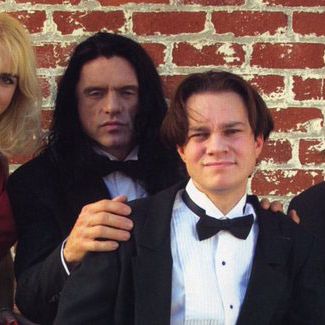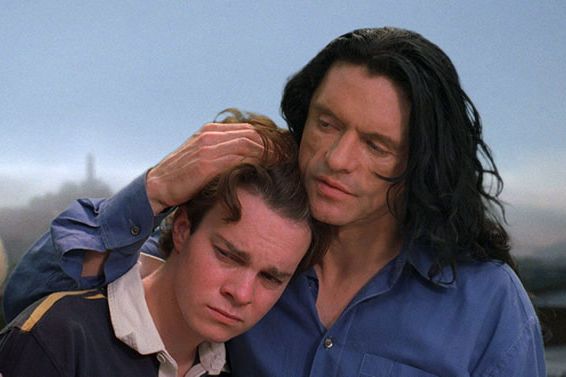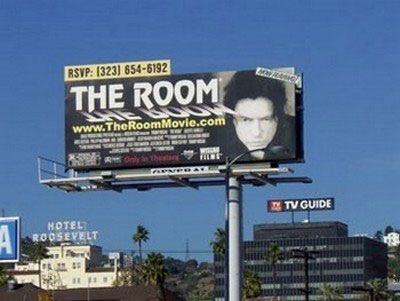
Ten years ago, in June 2003, a small independent film with a terrible script, a no-name director, and a cast of unknowns opened for a short run in Los Angeles. It was panned by the few critics who saw it and closed two weeks later, having grossed $1,800. But the film had something that set it apart. For while there are plenty of bad movies, there are no movies that are bad in all the ways The Room is bad. It suspends all normal rules of drama. Conflicts are introduced and then disappear instantly. Characters experience rapid mood swings, and everyone speaks in a weird brand of English filled with bizarre idioms. (“Keep your stupid comments in your pocket!”) The sex scenes are scarier than the scary scenes.
The Room hit theaters at the right time. As it turns out, its unending series of bizarre moments were perfect for the dawn of the Internet’s GIF and YouTube culture. As word of “the Worst Movie Ever Made” spread throughout message boards, an embryonic Room fandom coalesced around a series of midnight screenings in L.A. The movie’s director became the center of a strange cult of personality, one that grew to include some of the top names in Hollywood. With their help, The Room became an international phenomenon, replete with a computer game, a stage adaptation, countless memes, celebrity parodies, ironic scholarship, an upcoming tell-all memoir, and regular screenings in three countries. Here’s how the biggest cult movie of the past decade came to be.
Sometime in the Twentieth Century
Tommy Wiseau, The Room’s mysterious star-director-writer, is born. Little else is known.
Wiseau: ”[My past] has nothing to do with what I do. My private life is my private life.”
Juliette Danielle, Room cast member: “We tried for a long time to find out where he’s from. We never got an answer.”
Sometime in the Late Twentieth Century
Wiseau is inspired.
Wiseau: “I got the idea of The Room from life,” he says. “I conducted a lot of research, detailed work about human behavior, based on my environment. So I decided that I have this ‘concept,’ you know, about human behavior, and that’s where everything started.
The idea begins as a 600-page book, which Wiseau considers turning into a stage play. Eventually, he decides to make a film, written by, directed by, and starring himself.
1998
In an acting class in San Francisco, Wiseau meets Greg Sestero, who will become his right-hand man.
Sestero: “He went up onstage and was just so entertaining. The whole class was laughing and chanting his name, and he was getting into it with the teacher and I thought, This guy’s kind of cool. We just clicked. He told me, ‘I have a movie I’d love to make, and I think you’d be great.’”
2002
Production begins on The Room, though how Wiseau raised the film’s $6 million budget is a mystery. In interviews, the director says that he got it from his leather jacket business.
Wiseau: ”If you work, you have to save money, right? I didn’t get money from the sky. I was preparing, let’s put it this way.”
The cast has no illusions that they’re making a serious film.
Danielle: “I can remember one time that I just lost it. It’s the line where Johnny has locked himself in the bathroom and he says, ‘In a few minutes, bitch.’ I was doing okay until I saw the entire crew in my field of vision, stifling their laughter. I couldn’t help it. Tommy came out and demanded to know what was so funny. That made it worse!”
But Wiseau’s eccentricities hamper production.
Anonymous crew member: ”[The script] was actually a lot longer. There was stuff that was just unsayeable. I know it’s hard to imagine there was stuff that was worse. But there was.”
Sestero: ”[Production lasted] almost six months. It took longer than Transformers. That is sad.”

June 27, 2003
The film has its world premiere in Los Angeles. Wiseau arrives in a limousine.
Sestero: “People were hypnotized with laughter. Some people [walking out of the theater] looked dismayed. One guy said he may never get hard again.”
Variety critic Scott Foundas: “Given audience reaction at screening attended, pic may be something of a first: A movie that prompts most of its viewers to ask for their money back — before even 30 minutes have passed.”
By the end of its two-week run, the film has found a super-fan in screenwriter Michael Rousselet.
Rousselet: “‘It was like our own private Mystery Science Theater. I was calling friends during the end and saying, ‘You have to come to this movie.’ We saw it four times in three days, and on the last day I had over 100 people there.”

Late 2003
The first wave of Room diehards begin a campaign to bring the film back.
Wiseau: “We got several phone calls from the theater that people were campaigning because they wanted to see The Room. I said to myself, What the heck? We got thousands of e-mails.”
2004
The Room begins regular midnight screenings at the Laemmle Sunset in Los Angeles. Fans take to the Internet to sing the film’s praises.
IMDb user Brickyard Jimmy: “See this film at all costs. See it twice. Or three times. Or as one kid that I met from Woodland Hills has, 12 times! See it until you can recite every precious line of dialogue this movie has to offer. Let The Room become your new religion.”
Room fever infects the L.A. comedy scene. Members of the State seem particularly prone.
David Wain: “I was at Paul Rudd’s house a couple of years ago, and he said, ‘You have to watch this. Within two minutes, I’m like, ‘Okay, this is my favorite thing I’ve ever seen.’’’
December 2005
Wiseau releases the film on DVD, allowing Room fans to mock the film from the comfort of their homes.
May 5, 2006
NPR runs the first trend piece on Room screenings.
NPR: “During the movie, audience members shout out their own commentary about the dialogue, the sets — and notably, the framed photograph of a spoon that inexplicably reappears. Each time this happens, plastic spoons are thrown at the screen, in the can-do spirit of Rocky Horror Picture Show fans”
March 8. 2009
Tim and Eric, Room fans both, get Wiseau to guest-direct an episode of Awesome Show. Watch it here.
The experience is a strange one, even for them.
May 21, 2009
Monthly midnight screenings begin in New York City. The Room is now bicoastal.
July 24, 2009
The Room makes its London Premiere at Soho’s Prince Charles Theater.
The Independent: “The Room’s crappiness is so compelling that, rather than market it as the Greek tragedy it was so obviously meant to be be, Wiseau nowadays insists it was conceived as black comedy.”
April 30, 2010
The Room celebrates its one-year NYC premiere with a sell-out show at the 1,200-seat Ziegfield Theater. Wiseau is on hand to embrace the circus.
Entertainment Weekly: “While Sestero hung back, quietly signing autographs and taking pictures with fans, Wiseau — wearing a suit and those trademark sunglasses — was immediately bombarded with requests to pose in photos with football-wielding fans dressed in his likeness, and to sign shirts that read ‘I heart Tommy Wiseau.’ […] In fact, during the half hour that Wiseau rubbed elbows with fans outside the theatre, he was constantly surrounded by a mob worthy of Rob Pattinson, which made unknowing passersby curiously ask folks in line, “Who is that?”
September 7, 2010
With the arrival of an online computer game, The Room becomes fully meme-ified.
Vulture: “Can you find Lisa’s red dress in time?”
May 23, 2011
Sestero becomes Wiseau’s Boswell in earnest, signing a book deal with Simon & Schuster to write a tell-all about the making of the film. The Disaster Artist will hit shelves in October.
June 11, 2011
Wiseau’s vision finally comes full circle with a stage adaptation of The Room, which premieres at the AFI Silver Screen in Maryland. (Watch a video of it here.)
2013
Wiseau announces a special tenth-anniversary tour for the film, with appearances in Hollywood, Minneapolis, and Denver. He will likely introduce each of them with what has become his trademark phrase.
Wiseau: “I always say, ‘You can laugh, you can cry, you can express yourself, but please don’t hurt each other.’”


